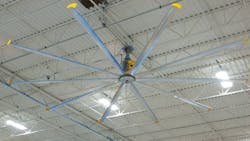When the temperature and humidity go up, the human body’s natural ability to cool itself goes down. OSHA considers temperatures of 100.4 degrees F and above to be dangerous for workers. As well as being simply uncomfortable, discomfort issues have a negative impact on productivity and the bottom line. Studies have shown that elevated temperatures affect our potential for both mental and physical work. Hot working conditions affect worker morale, absenteeism, turnover, quality of workmanship and the frequency of both accidents and grievances.
At McGraw-Hill, the high temperatures resulted in 15 heat-related incidents during one summer alone.
“It was an oven in this concrete building, and when workers were hot, they slowed down,” said McGraw-Hill Maintenance Manager Mike Price.
Air conditioning the 900,000 sq. ft. facility simply wasn’t an option, so Price opted for something you’d be more likely to expect in your own living room: an overhead fan. But not just any fan – thirty 24-ft. diameter fans.
Unlike inefficient, small fans that struggle to send air to the floor in tall spaces, these big fans use their immense size, not speed, to move air throughout an entire space, from high ceilings to the floor and wall to door. While air movement does not lower the actual temperature in a space, the perceived cooling effect can make a person feel 10 degrees F cooler – a big difference when workplaces hover near the limit of dangerous heat.
At McGraw-Hill, the effect was obvious – the facility went from 15 heat-related incidents in one summer to zero the next year, despite a heat wave with 120 days over 100 degrees F.
But these massive air movers can be used for far more than perceived cooling. They also can improve winter dexterity by running at a slower speed to gently push heat down, pass a thin sheet of moving air over cold surfaces to remove slippery condensation from floors, increase the effectiveness of your ventilation system and reduce noise in your facility (compare dozens of noisy, inefficient small fans to one overhead fan operating at less than 55 dBA).
From cooling employees working in hot areas to reducing condensation and destratifying heat, the power of air movement can aid distribution centers in a number of ways. In many cases, large-diameter, low-speed fans are a perfect fit to solve multiple safety issues in one fell swoop.
Erin Hsu is senior copywriter for Big Ass Fans, a designer and manufacturer of large diameter, low speed fans.

